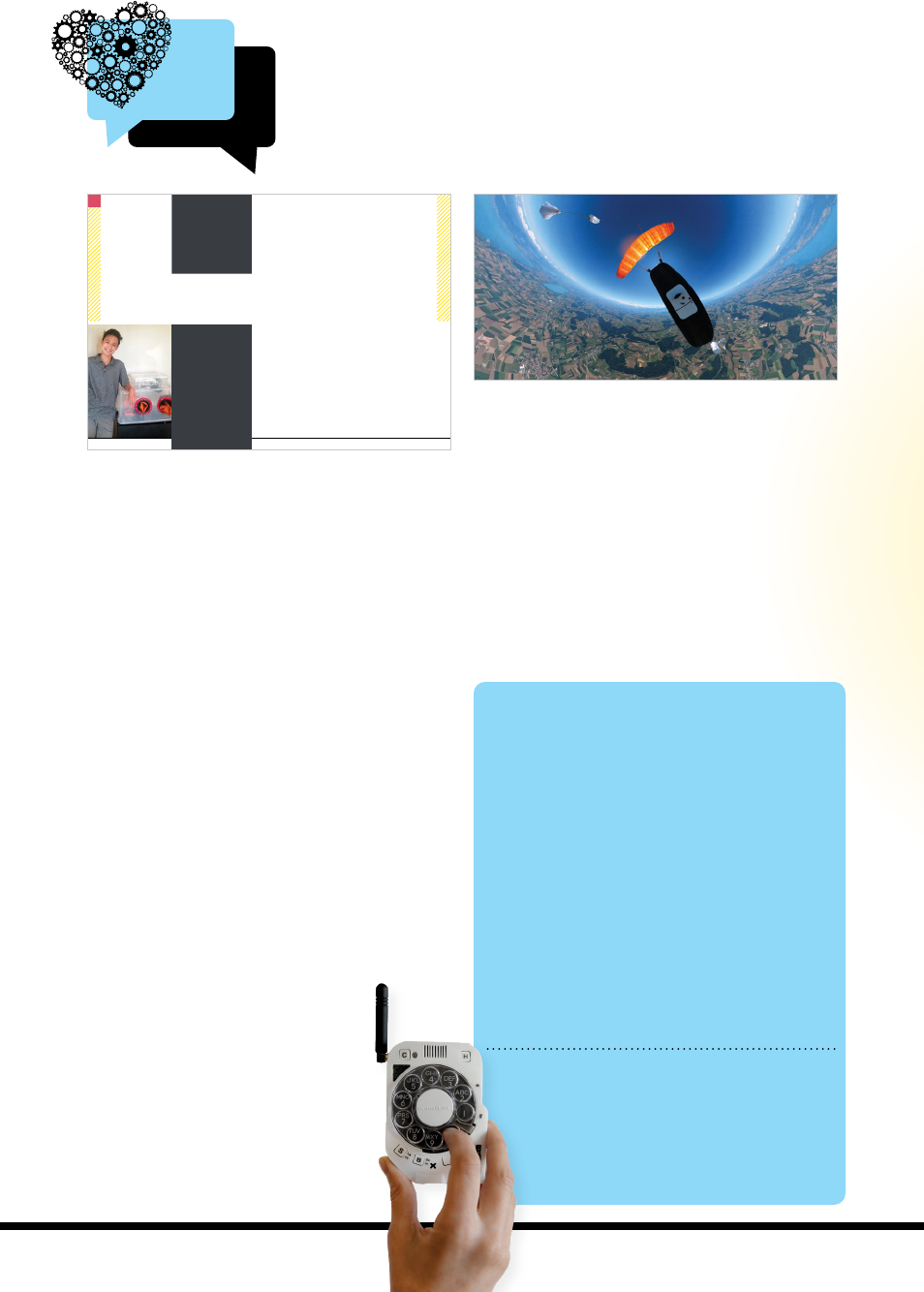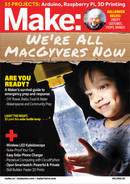
SCIENCE FAIR ACCOLADES
Congratulations to Caleb Kodama, who wrote
last issue (“Sick Sniffer,” Make: Volume 81) about
adapting Benjamin Cabé’s AI-powered artificial
nose (“Second Sense,” Volume 77) for a school
science fair project to detect fungal pneumonia. At
press time, Kodama had placed 2nd at the county
level and his pneumonia detector was headed for
the state competition. Well, the results are in:
“I just won First Place in the 71st annual
California Science & Engineering Fair. There were
854 participants from 343 schools throughout the
state who presented 720 projects in competition.”
MAKER FAIRE FORETOLD
Hired in 1967 to create an educational technology fair
at the San Mateo County fairgrounds, Stewart Brand
spent six months trying to raise money before giving
up the project. [His biographer] John Markoff notes
that the funding proposal reads like it is describing
the Maker Faire that happened 40 years later in the
same location. —Computer History Museum blog
A CELLPHONE FOR
ACTUALLY MAKING CALLS
Justine Haupt has turned her open-
source“Rotary Cellphone” (Volume 73)
into a convenient kit! Preorder the LTE-
ready Rotary Un-Smartphone (in beige,
atomic hotline red, and seafoam green,
no less) at skysedge.com/unsmart
phones/RUSP/index.html.
Gunther Kirsch
Sick
Sniffer
Sick
Sniffer
FEATURES Pneumonia Identier
I
was born two months ear ly, spending
the first month of my life in the hospital.
The doctors told my mother that I would
probably have physi cal and cognitive delays.
Bringing me home, my mom decided I would
never be treated any differe ntly because others
told her something couldn’t be done about the
challenges I could face in the futur e. As I grew,
she never once held back, not when I needed
speech therapy at age 3, nor when she was tol d
that I was eight months behind my peers in 4th
grade. No matter the obstac les that were put
in front of me, she persevered and kept movin g
forwar d. She always played puzzle games with
me and challenged me with ridd les. I didn’t
know it at the time, but these riddles and game s
like Myst and The Room helped me learn to look
at the big picture while simultan eously seeing
the smallest obscur e details. My mother’s
persever ance taught me that no matter what,
there is always a way.
Later in my childhood, I got pneumonia .
It was terrible, and unfor tunately, I was
misdiagnosed bec ause I barely had symptoms.
On our first trip to the hospital, I was sen t
home with antibiotic ear drops . Days later we
returned, and my mother pushe d the point with
my doctor. Once I was finally diagnosed with
pneumonia, which wa s almost a week after I
got sick, they didn’t know the type. Gener ally,
most people are diagnos tically assumed to
have bacterial pne umonia and given antibiotics;
they gave me three different t ypes over eight
days. My fever just would n’t quit, and on the
eighth day, I was scheduled to be admitted to
the hospital. Thank fully my fever finally broke
just beforehand, and I spent the next mont h
recovering . We n ever did determine what type of
pneumonia I had.
AN IDEA IS BORN
Pneumonia had a profound effe ct on my life, and
I began to wonder if I would have gotten sicker
had it not been for my mother’s unrelenting
persistence. Get ting sick also helped plant a
seed. I just couldn’t get the idea out of my head
that there has to be an easier way to help people
determine the type of pneum onia someone has.
I had wondered about this for four years , and
now, working on my 8th grade scie nce fair, I
thought I finally might have a chance to crack it.
To start, I began speaking to my aunt and
uncle, who are both doctor s. Initially, I simply
wanted to identify the ty pe of pneumonia faster,
without having to rely on a blood test , x-rays,
sputum samples , bronchial lavage, or the
industry gol d standard: gas chromatography
mass spectrom etry (GC/MS). Could I develop
something like a breathaly zer for disease?
My aunt and uncle referred me to a
pulmonologis t colleague of theirs who had just
so happened to be part of a study conduc ted
on detecting invasi ve aspergillus, or fungal
pneumonia, through pat ients’ breath. The study
focused on identif ying the metabolic signatures
of the disease using a GC/MS, and intere stingly
the chemical compounds as sociated were all
monoterpenes /terpenes. These are der ived
from plant essenti al oils, which was perfect!
This meant I could use safe, easily acces sible
substances such as citr us oil (limonene) and
nutmeg oil (camphene) for my testing , and
overcome the challeng es of using potentially
harmful culture s of fungal pneumonia and
acquiring the aid of someone who is autho rized
to deal with such samples.
THE NOSE KNOWS
I remembered reading , through my research,
how dogs could detect cancer by scen t. The
idea of scent then led me to electronic noses , or
E-Noses. There hav e been a few studies done on
other diseases like renal dis ease, which affects
the kidneys, and diabetes . The studies focused
on making a handheld device with a lar ge
enough sensor y array to detect those diseases
on the breath. One study used a Raspbe rry Pi,
and it gave me hope. Maybe I could build my own
E-Nose to detect fungal pneumo nia, and even
better, maybe I could make my E-Nose wireless .
I spent almost five long months doin g
Sick
Sniffer
I JUST COULDN’T GET THE IDEA
OUT OF MY HEAD THAT THERE
HAS TO BE AN EASIER WAY.
16 makezine.com 17
make.co
Heather Kodama (aka Mom)
CALEB KODAMA is a 9th grader from Pasadena,
California, who aspires to help the world through
science and engineering. In 2020 he won 1st place in
the Los Angeles County Science & Engineering Fair
and Top 300 in the national Broadcom MASTERS.
I BUILT AN AI NOSE
THAT “KNOWS”
FUNGAL PNEUMONIA
FOR MY 8TH GRADE
SCIENCE FAIR
Written by Caleb Kodama
I BUILT AN AI NOSE
THAT “KNOWS”
FUNGAL PNEUMONIA
FOR MY 8TH GRADE
SCIENCE FAIR
Written by Caleb Kodama
M81_016-19_PneumoniaNose_F1.indd 16-17M81_016-19_PneumoniaNose_F1.indd 16-17 7/6/22 12:49 PM7/6/22 12:49 PM
HIGH-ALTITUDE GPS CHUTE
Yohan Hadji (“Auto-Return Parachute,” Volume
80) writes: “The first high-altitude demonstration
was a full success. R2Home rose up to 3,500m
(11,400ft) under a weather balloon and autono-
mously detached before opening its paraglider
wing and flying back to land within 5 meters
of the launch point — and it returned an RS41
radiosonde sensor package, used for atmo-
spheric soundings all over the world. Next step:
20–30km (100,000ft). Serious game starts now.”
READER INPUT
TIMELY ROBOT COMBAT
I just received Volume 81, so happy. My son is
helping to set up a university robot wars team,
obviously fantastic information. Let me know
when I need to renew my subscription. Printed
words delivered to my mailbox makes me very
happy and elated. It’s like someone cares about
the future. —Jeremy Whitehurst
GREAT TO SEE A GREAT MAGAZINE IS BACK
I love getting Make: in print. It’s important to
have something so positive in these rugged
times. Fantastic issue! —Mike Winter
SHOW AND TELL US!
Send your tips, maker moments, project pics,
or thoughts on Make: to editor@makezine.
com, subject “Reader Input.” If we select
your note, we’ll send you a Make: hat!
6 makezine.com
FROM THE
EDITOR’S DESK
M82_006_RI_F1.indd 6M82_006_RI_F1.indd 6 7/11/22 11:58 AM7/11/22 11:58 AM
..................Content has been hidden....................
You can't read the all page of ebook, please click here login for view all page.
